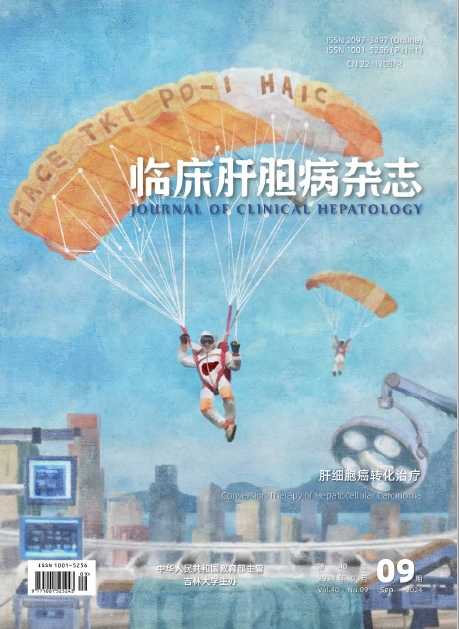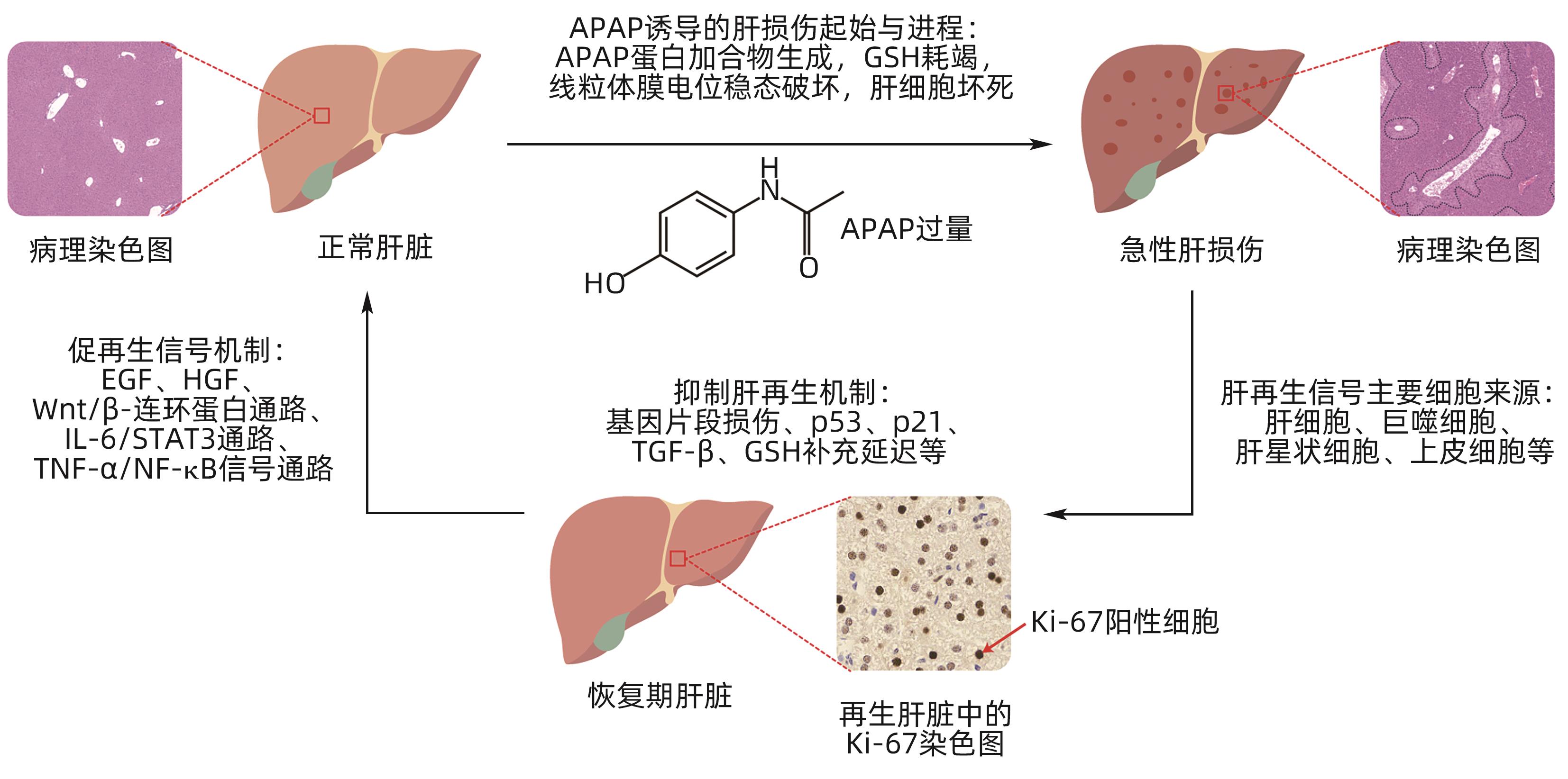| [1] |
XU Y, XIA Y, LIU QH, et al. Glutaredoxin-1 alleviates acetaminophen-induced liver injury by decreasing its toxic metabolites[J]. J Pharm Anal, 2023, 13( 12): 1548- 1561. DOI: 10.1016/j.jpha.2023.08.004. |
| [2] |
JAESCHKE H, RAMACHANDRAN A. Acetaminophen hepatotoxicity: Paradigm for understanding mechanisms of drug-induced liver injury[J]. Annu Rev Pathol, 2024, 19: 453- 478. DOI: 10.1146/annurev-pathmechdis-051122-094016. |
| [3] |
RAMACHANDRAN A, AKAKPO JY, CURRY SC, et al. Clinically relevant therapeutic approaches against acetaminophen hepatotoxicity and acute liver failure[J]. Biochem Pharmacol, 2024: 116056. DOI: 10.1016/j.bcp.2024.116056. |
| [4] |
APTE U, SINGH S, ZENG G, et al. Beta-catenin activation promotes liver regeneration after acetaminophen-induced injury[J]. Am J Pathol, 2009, 175( 3): 1056- 1065. DOI: 10.2353/ajpath.2009.080976. |
| [5] |
NGUYEN NT, UMBAUGH DS, SANCHEZ-GUERRERO G, et al. Kupffer cells regulate liver recovery through induction of chemokine receptor CXCR2 on hepatocytes after acetaminophen overdose in mice[J]. Arch Toxicol, 2022, 96( 1): 305- 320. DOI: 10.1007/s00204-021-03183-0. |
| [6] |
DONAHOWER B, MCCULLOUGH SS, KURTEN R, et al. Vascular endothelial growth factor and hepatocyte regeneration in acetaminophen toxicity[J]. Am J Physiol Gastrointest Liver Physiol, 2006, 291( 1): G102- G109. DOI: 10.1152/ajpgi.00575.2005. |
| [7] |
BHUSHAN B, WALESKY C, MANLEY M, et al. Pro-regenerative signaling after acetaminophen-induced acute liver injury in mice identified using a novel incremental dose model[J]. Am J Pathol, 2014, 184( 11): 3013- 3025. DOI: 10.1016/j.ajpath.2014.07.019. |
| [8] |
LUO TT, YANG SZ, ZHAO TM, et al. Hepatocyte DDX3X protects against drug-induced acute liver injury via controlling stress granule formation and oxidative stress[J]. Cell Death Dis, 2023, 14( 7): 400. DOI: 10.1038/s41419-023-05913-x. |
| [9] |
MANGIPUDY RS, CHANDA S, MEHENDALE HM. Tissue repair response as a function of dose in thioacetamide hepatotoxicity[J]. Environ Health Perspect, 1995, 103( 3): 260- 267. DOI: 10.1289/ehp.95103260. |
| [10] |
MICHALOPOULOS GK, BHUSHAN B. Liver regeneration: Biological and pathological mechanisms and implications[J]. Nat Rev Gastroenterol Hepatol, 2021, 18( 1): 40- 55. DOI: 10.1038/s41575-020-0342-4. |
| [11] |
KOMPOSCH K, SIBILIA M. EGFR signaling in liver diseases[J]. Int J Mol Sci, 2015, 17( 1): 30. DOI: 10.3390/ijms17010030. |
| [12] |
BHUSHAN B, KORAL K, STOOPS JW, et al. Hepatic deletion of MET aggravates acetaminophen hepatotoxicity and impairs liver regeneration in mice[J]. FASEB J, 2020, 34( S1): 1. DOI: 10.1096/fasebj.2020.34.s1.05879. |
| [13] |
WEI MJ, GU XN, LI H, et al. EGR1 is crucial for the chlorogenic acid-provided promotion on liver regeneration and repair after APAP-induced liver injury[J]. Cell Biol Toxicol, 2023, 39( 6): 2685- 2707. DOI: 10.1007/s10565-023-09795-9. |
| [14] |
KOTULKAR M, PAINE-CABRERA D, ABERNATHY S, et al. Role of HNF4alpha-cMyc interaction in liver regeneration and recovery after acetaminophen-induced acute liver injury[J]. Hepatology, 2023, 78( 4): 1106- 1117. DOI: 10.1097/HEP.0000000000000367. |
| [15] |
BHUSHAN B, CHAVAN H, BORUDE P, et al. Dual role of epidermal growth factor receptor in liver injury and regeneration after acetaminophen overdose in mice[J]. Toxicol Sci, 2017, 155( 2): 363- 378. DOI: 10.1093/toxsci/kfw213. |
| [16] |
ZHANG ZZ, YAO TT, ZHAO N, et al. Disruption of peroxisome proliferator-activated receptor α in hepatocytes protects against acetaminophen-induced liver injury by activating the IL-6/STAT3 pathway[J]. Int J Biol Sci, 2022, 18( 6): 2317- 2328. DOI: 10.7150/ijbs.69609. |
| [17] |
SCHMIDT-ARRAS D, ROSE-JOHN S. IL-6 pathway in the liver: From physiopathology to therapy[J]. J Hepatol, 2016, 64( 6): 1403- 1415. DOI: 10.1016/j.jhep.2016.02.004. |
| [18] |
CHIU H, GARDNER CR, DAMBACH DM, et al. Role of tumor necrosis factor receptor 1(p55) in hepatocyte proliferation during acetaminophen-induced toxicity in mice[J]. Toxicol Appl Pharmacol, 2003, 193( 2): 218- 227. DOI: 10.1016/j.taap.2003.07.003. |
| [19] |
BHUSHAN B, POUDEL S, MANLEY MW Jr, et al. Inhibition of glycogen synthase kinase 3 accelerated liver regeneration after acetaminophen-induced hepatotoxicity in mice[J]. Am J Pathol, 2017, 187( 3): 543- 552. DOI: 10.1016/j.ajpath.2016.11.014. |
| [20] |
POUDEL S, CABRERA DP, BHUSHAN B, et al. Hepatocyte-specific deletion of yes-associated protein improves recovery from acetaminophen-induced acute liver injury[J]. Toxicol Sci, 2021, 184( 2): 276- 285. DOI: 10.1093/toxsci/kfab115. |
| [21] |
XU M, WANG HC, WANG JX, et al. mTORC2 signaling is necessary for timely liver regeneration after partial hepatectomy[J]. Am J Pathol, 2020, 190( 4): 817- 829. DOI: 10.1016/j.ajpath.2019.12.010. |
| [22] |
MIREAULT M, PRINVILLE V, OHLUND L, et al. Semi-targeted profiling of bile acids by high-resolution mass spectrometry in a rat model of drug-induced liver injury[J]. Int J Mol Sci, 2023, 24( 3): 2489. DOI: 10.3390/ijms24032489. |
| [23] |
EVERTON E, DEL RIO-MORENO M, VILLACORTA-MARTIN C, et al. Growth hormone accelerates recovery from acetaminophen-induced murine liver injury[J]. BioRxiv, 2023: 2023. 04. 17. 537197. DOI: 10.1101/2023.04.17.537197. |
| [24] |
BORUDE P, BHUSHAN B, APTE U. DNA damage response regulates initiation of liver regeneration following acetaminophen overdose[J]. Gene Expr, 2018, 18( 2): 115- 123. DOI: 10.3727/105221618X15205260749346. |
| [25] |
BIRD TG, MÜLLER M, BOULTER L, et al. TGFβ inhibition restores a regenerative response in acute liver injury by suppressing paracrine senescence[J]. Sci Transl Med, 2018, 10( 454): eaan1230. DOI: 10.1126/scitranslmed.aan1230. |
| [26] |
XU PF, XI Y, WANG PC, et al. Inhibition of p53 sulfoconjugation prevents oxidative hepatotoxicity and acute liver failure[J]. Gastroenterology, 2022, 162( 4): 1226- 1241. DOI: 10.1053/j.gastro.2021.12.260. |
| [27] |
VISWANATHAN P, SHARMA Y, GUPTA P, et al. Replicative stress and alterations in cell cycle checkpoint controls following acetaminophen hepatotoxicity restrict liver regeneration[J]. Cell Prolif, 2018, 51( 3): e12445. DOI: 10.1111/cpr.12445. |
| [28] |
MARTUCCI N, MICHALOPOULOS GK, MARS WM. Integrin linked kinase(ILK) and its role in liver pathobiology[J]. Gene Expr, 2021, 20( 3): 201- 207. DOI: 10.3727/105221621X16113475275710. |
| [29] |
BHUSHAN B, EDWARDS G, DESAI A, et al. Liver-specific deletion of integrin-linked kinase in mice attenuates hepatotoxicity and improves liver regeneration after acetaminophen overdose[J]. Gene Expr, 2016, 17( 1): 35- 45. DOI: 10.3727/105221616X691578. |
| [30] |
HU CX, ZHAO LF, WU ZW, et al. Transplantation of mesenchymal stem cells and their derivatives effectively promotes liver regeneration to attenuate acetaminophen-induced liver injury[J]. Stem Cell Res Ther, 2020, 11( 1): 88. DOI: 10.1186/s13287-020-01596-9. |
| [31] |
CHANG WJ, SONG LJ, CHANG XJ, et al. Early activated hepatic stellate cell-derived paracrine molecules modulate acute liver injury and regeneration[J]. Lab Invest, 2017, 97( 3): 318- 328. DOI: 10.1038/labinvest.2016.130. |
| [32] |
SHEN KT, CHANG WJ, GAO XD, et al. Depletion of activated hepatic stellate cell correlates with severe liver damage and abnormal liver regeneration in acetaminophen-induced liver injury[J]. Acta Biochim Biophys Sin, 2011, 43( 4): 307- 315. DOI: 10.1093/abbs/gmr005. |
| [33] |
DONAHOWER BC, MCCULLOUGH SS, HENNINGS L, et al. Human recombinant vascular endothelial growth factor reduces necrosis and enhances hepatocyte regeneration in a mouse model of acetaminophen toxicity[J]. J Pharmacol Exp Ther, 2010, 334( 1): 33- 43. DOI: 10.1124/jpet.109.163840. |
| [34] |
KATO T, ITO Y, HOSONO K, et al. Vascular endothelial growth factor receptor-1 signaling promotes liver repair through restoration of liver microvasculature after acetaminophen hepatotoxicity[J]. Toxicol Sci, 2011, 120( 1): 218- 229. DOI: 10.1093/toxsci/kfq366. |
| [35] |
STARKEY LEWIS P, CAMPANA L, ALEKSIEVA N, et al. Alternatively activated macrophages promote resolution of necrosis following acute liver injury[J]. J Hepatol, 2020, 73( 2): 349- 360. DOI: 10.1016/j.jhep.2020.02.031. |
| [36] |
BEN-MOSHE S, VEG T, MANCO R, et al. The spatiotemporal program of zonal liver regeneration following acute injury[J]. Cell Stem Cell, 2022, 29( 6): 973- 989. e 10. DOI: 10.1016/j.stem.2022.04.008. |








 DownLoad:
DownLoad: